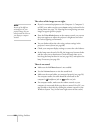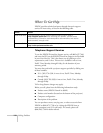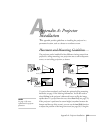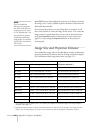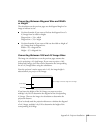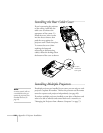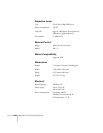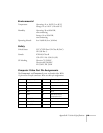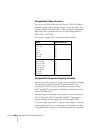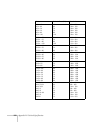
Appendix A: Projector Installation 115
Converting Between Diagonal Size and Width
or Height
The calculations on the previous pages use the diagonal length of an
image to indicate its size.
■ Use these formulas if you want to find out the diagonal size of a
4:3 image from its width or height:
Diagonal size = 5/4 × width
Diagonal size = 5/3 × height
■ Use these formulas if you want to find out the width or height of
a 4:3 image from its diagonal size:
Width = 4/5 × diagonal size
Height = 3/5 × diagonal size
Converting Between 16:9 and 4:3 Image Sizes
The image size calculations on on the previous pages assume that
you’re projecting a 4:3-sized image. If you want to project a 16:9
(widescreen) image, you’ll first need to determine the corresponding
size of a 4:3 image before using the calculations.
Since the projector’s native aspect ratio is 4:3, the image height is
reduced when you project a 16:9 image:
If you know the height of the 16:9 image you want to project,
multiply it by 20/9 to determine the diagonal of the corresponding
4:3 image. Then use the image size calculations to determine the
projection distance.
If you’ve already used the projection distance to calculate the diagonal
of a 4:3 image, multiply it by 9/20 to determine the height of the
corresponding 16:9 image.
16:9 image
4:3 image
16:9 image is 75% as high as 4:3 image




